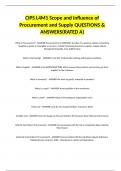CIPS L4M1 Scope and Influence of
Procurement and Supply QUESTIONS &
ANSWERS(RATED A)
What is Procurement? - ANSWER Procurement is a STRATEGIC function of a business obtains something
Tangible as goods or Intangible as services. Include Purchasing Inventory, Logistics, Supply, Waste
Management Quality, Cost, Added Value
What is Purchasing? - ANSWER Is the ACT of physically ordering and buying something.
What is Supply? - ANSWER Is the INFRASTRUCTURE which ensures that products and services get from
supplier to the customer.
What is inventory? - ANSWER the stock of goods, materials or products
What is a stock? - ANSWER Asset available in the warehouse
What is asset? - ANSWER Value of everything an organization owns
Fixed cost - ANSWER Costs do not change (Salaries, Insurance, Rent)
Variable Cost - ANSWER Costs do change as they are linked to the business (Raw Material, Extra hours)
Directly Cost (Direct Procurement) - ANSWER Cost associated with the Job or production (Raw material,
Man Power)
Indirectly Cost (Indirect Procurement) - ANSWER Not associated with the Job (Clean Liquid, Stationary,
Mobile phones contracts, MRO - Maintenance repairs and Operations.
, Primary Sector of the Economy - ANSWER The part of the economy that draws raw materials from the
natural environment (Cotton, Oil, Silver, Wheat)
Secondary sector of the Economy - ANSWER The part of the economy that transforms raw materials into
manufactured goods (Light Bulbs, Nuts and Bolts, Metal housing, Plastic fittings)
Finished goods - ANSWER Units of products that have been completed but not yet sold to customers
(Shoes, Beds, Clothes, Jewellery)
Stock Procurement Includes - ANSWER Can be stored and inventory Raw Material, Components and
Finished Goods.
Non-Stock Procurement Includes - ANSWER Are not stored and not listed in the Organization inventory
(Cleaning Services, Internet Contract, Insurances, Advertising Campaigns)
Explain why the procurement department should be consulted before an organization spends money. -
ANSWER Procurement can influence the majority of the costs within an organization:
1.- Evaluating potential suppliers
2.- Involved in preparing specifications
3.- Review Quality standards
4.- Assess ethical requirements
5.- Compare buy or lease options
6.- Investigate transport
7.- Review packing options.
8.- Research total life cost
9.- Calculate currency differences
10.- Benchmark prices
11.- Ensure assets are fit for a propose
Total life Cost (TLC) - ANSWER The total amount a product will cost an organization.
,Mentioned some examples of NON-STOCK INTANGIBLE procurements. - ANSWER Insurance, Marketing,
Salaries/Pensions, Cleaning, IT and Catering Services, Staff Development, Electricity, Gas, Rent or
Mortage.
Mentioned some examples of STOCK TANGIBLE procurements. - ANSWER Components, Stationary,
Uniforms
List the Pre-award process (Sourcing) in Procurement Cycle - ANSWER From 1 to 8
1.-Understand the need
2.- Market/commodity
3.- Develop a strategy
4.- Pre procure
5.- Develop Documentation
6.- Supplier Selection
7.- ITT/RFQ
8.- BID/TENDER
Mention the award process (Contract/ PO) in Procurement Cycle - ANSWER 9.- Contract Award
List the Post-award process (Contract Management) in Procurement Cycle - ANSWER 10.- Warehouse
Logistics
11.- Contract Performance
12.- SRM & SC Management
13.- Asset Management
Product specification - ANSWER Describes the technical criteria
Typical Specification Outlines - ANSWER Description, Drawing, Color, Materials, Quantity, Packing,
Quality.
, Performance Specifications - ANSWER Simple to prepare. Open up the supplier market and promote
innovation and competition by letting suppliers offer the solution to the required need.
Conformance Specifications - ANSWER Usually difficult to prepare. Ensure that the product/service is
exactly as required and that there is not variance. (Recipes, Chemical formulas, engineering drawings)
Why should a service specification contain as many details as possible? - ANSWER To ensure that the
standard of quality demand is met.
Rights of Procurement - ANSWER 1.- Right Quantity
2.- Right Quality
3.- Right Time
4.- Right Place
5.- Right Price
Define why the Five rights of procurement and supply are important to the procurement professional. -
ANSWER 1.- Quantity: if is wrong Warehouse Could be overstocked and Production could be stop.
2.- Quality: Essential of getting value of money.
3.- Time: If products are not received, serious consequences for the production.
4.- Place: Additional cost may be incurred if delivery sent to wrong destination.
5.- Price: Must be fair and reasonable, need to consider Currency, Taxes, Incoterms.
What is the other right of procurement and supply? - ANSWER Right Source (Selection of the right source
is a very important)




